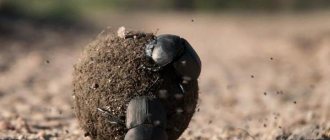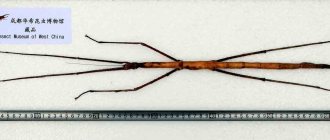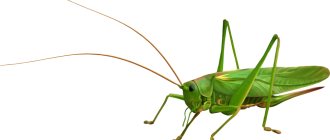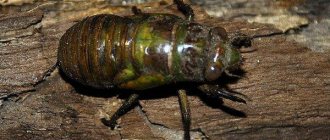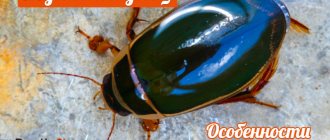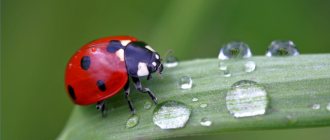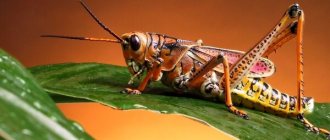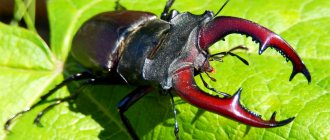- Wild animals
- >>
- Insects
During the warm season, you can meet many different insects on the street, each of which performs its own functions in the natural environment. Insects are constantly busy with something, most of them work directly for the benefit of people. One of these “hard workers” is the fireman beetle . This is a cute creature with a bright and memorable appearance. You can learn in detail about its role in nature and development features from this publication.
Origin of the species and description
Photo: Fireman Beetle
The fireman beetle is a medium-sized insect that got its name because of its original appearance, which includes red elements in its color. Quite often, this animal is confused with other beetles, called soldier bugs, onion rattles and bee moths by firemen. However, these are all completely different insects, with their own habits and external features.
Video: Fireman Beetle
Biologists also call firefighter beetles red-legged soft beetles. This is due to the bright burgundy color of the beetle’s legs and the absence of chitinous cover. The elytra of insects are very flexible and soft. Therefore, people believe that firefighters, like other representatives of soft-bodied animals, are more likely than others to be attacked by other animals and predators. But that's not true! These bugs can take care of themselves.
Interesting fact: Unfortunately, firefighting beetles have a very short lifespan. For this reason, such animals are able to reproduce within four weeks after their birth.
The fireman beetle is an insect of the soft-bodied family, order Coleoptera. It is quite easy to recognize this creature. His head is decorated with small antennae, very thin, resembling threads. These antennae are constantly in motion. There is a dark spot at the top of the head. It is by this that one can distinguish the fireman's beetle from other beetles. The body is rectangular, elongated. Adults rarely grow more than 1.5 centimeters in length. The belly is painted a bright burgundy color.
Firefighter beetles are usually found in gardens and are beneficial to humans. They effectively exterminate a huge number of insect pests. However, sometimes the population of such beetles grows very large and it becomes necessary to exterminate them. Firefighter beetles do not have to be poisoned, thereby polluting your own garden. Such insects can simply be collected by hand. But this method is relevant if the beetles have not yet had time to multiply very much. Otherwise, you can flavor the plants with a mixture of cheap tobacco and wood ash.
Humane methods of control
Of course, it is not very pleasant to destroy an insect that helps get rid of pests in your favorite garden.
But sometimes you have to make sacrifices for your own good. How to deal with the fireman beetle so that your heart doesn’t hurt and your conscience doesn’t torment you? There are several humane ways: Instead of tobacco, you can take the cheapest cigarettes, such as Prima, and prepare a repellent.
Appearance and features
Photo: What a fireman beetle looks like
The fireman beetle is a rather striking representative of its family due to its very original appearance.
A firefighter can be distinguished by the following external features:
- original body color. The elytra are painted black, the abdomen and legs are brown or bright red. From above, the animal very much resembles a fire engine, from which it gets its name;
- average body size. The body has a slightly flattened shape and is distinguished by a soft structure. There is no strong, hard chitinous coating. The length usually does not exceed 1.5 centimeters. The top of the body is densely covered with hairs;
- retracted head There is a dark spot near the head. This is a characteristic feature of a firefighter. There are antennae on the head. They consist of eleven joints;
- soft wings and tenacious legs. The wings completely cover the back and are painted in a dark gray shade. The paws are colored red, they are quite strong and have small claws;
- presence of gender differences. In particular, females are always larger than males. Their pronotum is decorated with a symmetrical spot. This spot has an individual shape for each beetle. This makes them unique;
- presence of mandibles. The mandibles are slightly curved and very sharp. With their help, the beetle can pinch painfully. The mandibles are used by insects during hunting. The fireman beetle is a predator. It attacks small insects.
Paleontology
More than 50 fossil species of soft-bodied animals have been discovered. The oldest forms of Cantharidae were found in the Early Cretaceous in Lebanese amber (about 130 million years old), Burmese amber (about 100 million years old) and Spanish amber (about 110 million years old)[6].
- Cretaceous Katyacantharis zherikhini Kazantsev & Perkovsky, 2019 (90 million years)[7]
- Ornatomalthinus elvirae Poinar & Fanti, 2016 (97-110 Ma)[8]
- Myamalycocerus vitalii Fanti & Ellenberger, 2016 (97-110 Ma)[9]
- Archaeomalthodes rosetta Hsiao et al., 2016 (97-110 Ma)[10]
- Elektrokleinia picta
Ellenberger & Fanti, 2022 (100 Ma)[11]
- Lithocantharis lunglokshuiensis Lin, 1997 [66-56 Ma], Peng Chau Island, Lung Lok Shui (Hong Kong)
Dominican amber
- Tytthonyx geiseri Poinar & Fanti, 2016 [from 45-30 Ma to 20-15 Ma - Eocene or Miocene]
Baltic amber
- Cantharis nigricans Burmeister, 1832 [38/37.2-33.9 Ma]
- Cantharis sucinonigra Kuśka, 1992 [38/37.2-33.9 Ma]
- Cantharis sucinokotejai (Kuśka, 1996) [38/37.2-33.9 Ma]
- Electronycha prussica Kazantsev, 2013 [38/37.2-33.9 Ma]
- Ragonycha kryshtofovichi (Yablokov-Khnzorian, 1960) [38/37.2-33.9 Ma]
- Rhagonycha sucinobaltica Poinar & Fanti, 2016 [38/37.2-33.9 Ma]
- Sucinocantharis baltica Kuśka & Kania, 2010 [38/37.2-33.9 Ma]
- Sucinorhagonycha kulickae Kuśka, 1996 [38/37.2-33.9 Ma]
- Themus pristinus Kazantsev, 2013 [38/37.2-33.9 Ma]
- Cacomorphocerus cerambyx Schaufuss, 1892 [38/37.2-33.9 Ma]
- Cacomorphocerus jantaricus (Kuśka & Kania, 2010) [38/37.2-33.9 Ma]
- Macrocerus sucinopenninus (Kuśka & Kania, 2010) [38/37.2-33.9 Ma]
- Malthinus danieli Kuśka & Kania, 2010 [38/37.2-33.9 Ma]
- Malthodes ceranowiczae Kuśka & Kupryjanowicz, 2005 [38/37.2-33.9 Ma]
- Malthodes kotejai Kuśka & Kupryjanowicz, 2005 [38/37.2-33.9 Ma]
- Malthodes serafini Kuśka & Kupryjanowicz, 2005 [38/37.2-33.9 Ma]
- Malthodes sucini Kuśka & Kania, 2010 [38/37.2-33.9 Ma]
- Mimoplatycis notha Kazantsev, 2013 [38/37.2-33.9 Ma] - also in Rivne amber
- Curche pauli Alekseev & Kazantsev, 2014 [38/37.2-33.9 Ma]
- Electrosilis minuta Kazantsev, 2013 [38/37.2-33.9 Ma]
Rivne amber
- Malthodes perkovskyi Kazantsev, 2010 [38/37.2-33.9 Ma]
- Malthodes rovnoensis Kazantsev & Perkovsky, 2014 [38/37.2-33.9 Ma]
Florissant (USA)
- Atalantycha humata (Wickham, 1913) [37.2-33.9 Ma]
- Ragonycha hesperus (Wickham, 1914) [37.2-33.9 Ma]
- Podabrus cupesoides Wickham, 1917 [37.2-33.9 Ma]
- Podabrus florissantensis Wickham, 1914 [37.2-33.9 Ma]
- Podabrus fragmentatus Wickham, 1914 [37.2-33.9 Ma]
- Podabrus wheeleri Wickham, 1909 [37.2-33.9 Ma]
- Chauliognathus pristinus Scudder, 1876 [37.2-33.9 Ma]
- Trypherus aboriginalis Wickham, 1913 [37.2-33.9 Ma]
- Polemius crassicornis Wickham, 1914 [37.2-33.9 Ma]
Where does the fireman beetle live?
Photo: Firefighter Beetle in Russia
The appearance of the fireman's beetle always attracts the eye and arouses genuine interest among adults and children. Such an insect cannot be ignored during the warm season. It is usually found in gardens, orchards, and other places where garden plants grow. Their population is especially huge where raspberries and currants grow. Firefighter beetles don't particularly like attention. When a person approaches, they try to quickly leave their place.
Interesting fact: Firefighting beetles provide invaluable benefits. They exterminate a huge number of pests. But there is also harm from such insects. Firefighters can damage some types of fruit and vegetable crops and garden plants.
The firefighter beetle is a ubiquitous insect. It is found wherever there is a cold or temperate climate. But the main requirement of these beetles is the availability of food suitable for them. There are large numbers of firefighter beetles in Europe, Russia, Ukraine, Belarus, Georgia and many other countries.
Softworms reproduce quickly, but do not live long. These insects choose cultivated places to live. They can be found wherever there are plantings of fruit trees, raspberry bushes, currants, and gooseberries. They also prefer to live in vegetable gardens. Small populations of such insects are even welcomed by gardeners. This is not surprising, because firefighters help get rid of caterpillars, aphids, mosquitoes, midges and other pests.
Interesting fact: The fireman beetle is a safe and highly effective means of getting rid of cockroaches. In order for the Prussians to leave the living quarters, it is necessary to send several firefighters there and leave them for a while.
Now you know where the fireman beetle is found. Let's see what he eats.
Soft-bodied family
The fireman's beetle is often briefly called the "soft beetle." But in fact, this is a large genus, and the fireman is one of the famous representatives. All of them are predators, as their name suggests, with soft shells and bright colors.
The species is most common in temperate forests. It seems as if they have two states - active mating or sitting on a leaf, eating the prey.
Unlike most representatives of the species, it has black legs and back. Sometimes grayish. They are found in the European part of Russia and the forests of Siberia.
What does the fireman beetle eat?
Photo: Red Beetle Fireman
The fireman beetle, despite its “softness,” is a rather formidable predator. This insect has very powerful jaws. It is these jaws that enable the beetle to deftly absorb small insects.
A firefighter's daily diet includes:
- aphids;
- small caterpillars;
- sleepy flies;
- larvae of various insects;
- small chafers (those species that feed on leaves).
Looking at the beetle's diet, it is easy to realize that it prefers to eat only those insects that are much smaller than its own size. In addition, firefighter victims often have a soft body structure. This predator cannot cope with too hard chitinous cover, even with the help of its powerful jaws. The beetle avoids such insects.
The fireman's beetle's hunting process begins in the air. He looks out for his next victim during the flight. Having found a suitable insect, the fireman lands in close proximity to it or even directly on the animal. Next comes the jaws. The fire beetle stabs them into its prey, releasing a toxic substance as it does so. One portion of poison can significantly soften tissue, so the further process of food absorption is quite easy.
In the larval stage, the firefighter beetle eats a little differently. Its diet consists mainly of small worms and centipedes. Beetle larvae find such food right in their habitat - in rotten stumps, in old trees. For this reason, it is highly not recommended to remove stumps and old wood from the garden. Firefighting beetles could be of great benefit in the future.
Nutrition
The predatory nature of firefighter beetles manifests itself in the hunt for a variety of insects: aphids, caterpillars, small leaf beetles, and the larvae of other soft beetles. Organisms protected by a chitinous covering are too tough for the firefighter beetle.
Red-legged softies approach their prey closely or sit on it. They press with their jaws from all sides until the resistance stops. Sharp and strong sickle-shaped jaws, which are designed specifically for holding, not chewing, help preserve prey.
Injecting poison and digestive juice into the victim’s body helps convert what they catch into food. The diet includes insects whose size is smaller than the predator itself.
Features of character and lifestyle
Photo: Fireman beetle in nature
In appearance, the fireman beetle evokes only positive emotions. But its harmless appearance hides a real predator. Firefighter beetles spend almost all day hunting. They stalk their prey in flight, then grab it with their powerful jaws, bite it, and then consume it after exposure to venom. In warm weather, firemen can often be seen on various plants. There they not only bask in the sun, but can also have a snack. Insects gnaw only the fleshy parts of plants.
Firefighter beetles lead an active lifestyle. During the day they fly a lot, love to land and sit for a long time on plants, grass, flowers and fruit trees. These insects are attentive and have a good reaction. If any object approaches, they instantly fly into the sky. If it fails to fly away, the insect can pretend to be dead. To do this, it tucks its paws under itself.
Interesting fact: You should not try to pick up a fireman's beetle. He bites very painfully and releases a special odorous substance at his offender. The insect has sharp teeth and powerful jaws. The bite is quite painful.
Soft beetle larvae spend their day differently. They live on fallen leaves, soil or old wood. They overwinter under the roots of trees, buried deep in the soil or under foliage. The larvae have three pairs of legs, so they move easily and quickly. With the help of powerful jaws, they make their way, making tunnels in the tree. Little firemen feed on centipedes and worms. Outside the shelter, larvae appear very rarely. The only exception is the period of active snow melting. The larvae crawl out to escape the melt water.
Use of entomophages on the site (with video)
In order for entomophagous insects to settle on the site, it is necessary to constantly carry out activities that can be roughly divided into two groups.
The first group of measures is aimed at attracting these creatures to the garden, and the second is aimed at keeping them on the site.
In order to attract beneficial insects, you need to plant honey plants. Moreover, it is best to plant these crops in 2-3 terms - so that they bloom throughout the season. Insects that are beneficial to hell and the garden prefer crops with small, “nondescript” flowers. In many cases, wild plants or perennial ornamental plants are used for this.
You can build flower beds on the site or plant the necessary crops between the rows (for example, dill).
It is best if the area is surrounded by a hedge consisting of wild shrubs at the flowering stage. It is not recommended to mow the grass, since you need to create a kind of ring from the grass growing in the area.
Sometimes you need to organize an “oasis” of wildlife on your property, which is a piece of uncultivated land with two or three flowering shrubs and one tall old tree.
There should be a non-drying shallow body of water, next to which insects will definitely settle.
Another effective way to “settle” entomophagous insects in your garden is to make wintering houses for them that imitate natural shelters.
Dry grass or leaves, pieces of tree bark and twigs are usually placed inside them. Houses are usually located near plants affected by pests - both garden crops and fruit and berry crops. Such structures, if approached creatively, can become an excellent decoration for the site.
Watch the video on how you can attract beneficial insects to your site:
The importance and economic feasibility of work on the introduction of beneficial organisms for the purpose of using their entomophages against pests and weeds is indisputable. However, this area of plant protection already requires new methods
It is necessary to purposefully unite research in the field of introduction under the leadership of a single scientific center equipped with modern equipment. This center, in addition to coordination, also performs control functions aimed at preventing the entry of new species of pests into a certain territory. At the same time, it is also necessary to organize expeditions to search for new useful species. In addition, it is important to expand the interstate exchange of beneficial organisms. All these actions will lead to a further increase in the share of the biological method in the system of measures that ensure plant protection.
The following describes in detail which beneficial entomophagous insects protect plants from pests and how to attract them to the garden.
Social structure and reproduction
Photo: Insect fireman beetle
Soft cows mate only when warm weather arrives. The sun should warm the air and soil well. Typically, the period of procreation occurs in the summer - July. First, females and males split into pairs, then mate. After some time, the female lays eggs in the substrate. It should be soft and warm. Leaf litter on the soil, decaying plants, stumps, wood debris, and rotten branches are ideal for this.
To mature, eggs need some time - from fifteen to twenty days. The incubation period largely depends on the air temperature. After maturation, larvae are born. Outwardly, they very much resemble beads. The larvae are completely covered with hairs. They are small and have three pairs of legs. The larvae of fire beetles are very cute and interesting. The beetle larvae develop quickly, but at this stage they live for quite a long time.
Firefighter larvae, like adults, are predators. They eat small worms and centipedes as food. Also very interesting is the fact that larvae are characterized by digestion outside the intestine. How does this happen? Extraintestinal digestion involves the use of a special substance, poison. The larva injects this poison directly into the body of the victim, it almost instantly dissolves the tissues of the prey. Then the larva just needs to suck up the liquid food.
Closer to winter, pupation of larvae occurs. But only some of the larvae turn into pupae. The other part simply spends the winter in their shelter. In spring, the pupae turn into caterpillars and crawl out. People nicknamed the furry caterpillars “snow worms.” Then, with the onset of warmth, young firefighter beetles appear.
Biological characteristics
If you look closely at the picture presented above, you can see its similarity to a fire truck, most likely this is the answer to the question why the fireman beetle is called that. And if we turn over this small insect, which is only one and a half centimeters long, we will see a red belly, once again reminding those who want to eat it of the danger.
The description of the fireman's beetle should be supplemented by the fact that its body consists of seven joints and its antennae of eleven. The pronotum, the first segment of the red body, has a black spot, and the soft wings are dark gray.
Let's complete the description of what a firefighter beetle looks like with information about sexual dimorphism, the differences between individuals of different sexes. In a particular case, you can see that the male red-legged softy calf is noticeably smaller than the female.
Reproduction
After the sun warms the air and soil well, the soft-bodied animals mate. Typically the breeding season occurs in mid-summer, July. Soon after mating, the female lays fertilized eggs in a soft substrate. It can be leaf litter on untouched soil, or decomposing plant debris: rotten tree branches, boards, stumps and other wood debris left to rot.
The eggs are incubated for 15-20 days, depending on the ambient temperature, and emerge into a furry larva that looks a bit like a piece of a fashionista's necklace.
The fireman's beetle larva is interesting in several ways. Firstly, it is characterized by extraintestinal digestion. Secondly, she herself is a predator, like adults.
Reference! Extraintestinal digestion occurs by injecting food juice into the victim’s body, a special substance under the influence of which body tissues dissolve. After this, the predator sucks up the ready-made liquid food.
By winter, some of the larvae pupate, while others overwinter in rotten leaves or rotten wood. I call the red-legged softworm caterpillars crawling out into the sun in the spring “snow worms.”
Soon after warming in nature, the larvae pupate and two weeks later young firefighter beetles emerge from them.
It's time to tell you what firefighter beetles eat. This point is especially important in the sphere of understanding who this insect really is - a friend who protects our cultivated plants, or an enemy - a pest of the garden.
The diet of soft-bodies includes all insects that are smaller in size and also have a soft body, due to the fact that the hard chitinous cover is too tough for a firefighter. By biting through the flesh of the victim with their jaws, similar to a snake's mouth, they inject poison and digestive juice into them.
- aphids;
- small caterpillars;
- various larvae;
- leaf beetles on different crops.
The larvae feed on small worms, centipedes, and various larvae. In terms of the number of pests destroyed, they can exceed adults.
Reference! Imago is the last stage of insect development, its adult form. In relation to firefighters - this is how you can call a beetle.
There are obvious benefits from firefighter beetles, because by destroying pests, they save the plants we cherish.
At the same time, if there are enough soft beetles, they are able to spread to plant food, they damage the flowering buds, petals and leaves of some fruit crops. In this regard, the obvious harm of firefighter beetles is visible.
Despite this, most experts are inclined to believe that the benefits of these insects significantly outweigh the harm that is small by garden standards, and only if it occurs in some years. It is indicative that earlier in the villages they fought cockroaches with the help of the red-legged softy. It was enough for the firemen to launch a few beetles into the house, and the Prussians soon left it.
Natural enemies of firefighter beetles
Photo: What a fireman beetle looks like
The fireman beetle is a unique creature. Despite his modest size and very soft body structure, the firefighter successfully resists natural enemies. The thing is that in nature, the bright red color of the body indicates great danger. Predators, birds and other animals try to avoid such beetles, preferring easier and safer prey.
Why is the fireman beetle so dangerous to other animals? The red color of this insect indicates its high toxicity. It is so indeed. In case of danger, a fireman bites painfully and shoots a special poison at his offender. For many animals this poison can be fatal; for others it will cause a huge number of health problems.
Only occasionally are fire beetles attacked by birds of prey and some amphibians. They can also become prey for domestic animals. The most dangerous enemy of firefighters is man. When these beetles multiply rapidly, people resort to exterminating them using various methods. In the fight against firefighters, both humane and lethal methods are used. The thing is that too large a population of these insects can cause significant damage to plants, bushes and trees.
Interesting Facts
In addition to its bright color, the insect is interesting because:
- The venom of the soft belly has a specific odor;
- the red spot on the pronotum is individual for each beetle, like fingerprints or the auricle of a person;
- the insect is not afraid of temperature changes; in temperate latitudes the beetle feels great;
- not afraid of insects and birds of prey, the main defense is poison;
- The saving grace for a firefighter can be the ability to pretend to be dead in case of danger;
- the insect is an excellent analogue to the chemical treatment of garden plants against pests;
- the beetle has no upper lip;
- It is not difficult to catch a beetle in flight; its movement speed is not high.
The fireman beetle will bring a lot of benefits in the garden and on the plot: it will rid plants of aphids and help cope with caterpillars and flies. However, large numbers of insects can destroy the harvest of some stone fruits; it is advisable to monitor their numbers.


